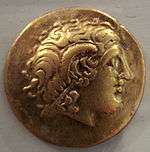Caletes
The Caletes or Caleti (Gaulish: "the hard [stubborn, tough] ones"; Latin: Calētēs or Calētī) were a Belgic or Gallic tribe living in Pays de Caux, in present-day Normandy.
Name
They are mentioned as Caletes by Caesar (mid-1st c. BC),[1] as Káletoi (Κάλετοι) and Kalétous (Καλέτους) by Strabo (early 1st c. AD),[2] as Galetos by Pliny (1st c. AD),[3] as Kalē̃tai (Καλη̃ται) by Ptolemy (2nd c. AD),[4] and as Caleti by Orosius (early 5th c. AD).[5][6]
The name Calates ('the hard [i.e., stubborn, tough] ones'), stems from the Gaulish root caleto- ('hard'), itself from Proto-Celtic *kaleto- ('hard, cruel, strong'; compare with Old Irish calath 'heroic', Middle Welsh caled 'hard'), ultimately from Proto-Indo-European *ḱelto- ('cold'; compared with Av. sarǝta- 'cold', OE haeled 'hero', Lat. callēre 'to be hardened [by the experience], insensible').[7]
The city of Calais, attested as Kaleis in 1181–1182, is named after the Gallic tribe, perhaps after the settlement of Cateles migrants.[8] They also gave their name to the Pays de Caux, attested as Pago Calcis in 843 (Kaleto in 1206).[8][9]
Geography
The territory of the Calates closely corresponded to the Pays de Caux.[8] They dwelled north of the neighbouring Veliocasses, and were separated from the Ambiani in the northeast by a minor tribe, the Catoslugi.[9]
They occupied a section of the coast, between the Sequana and the Phrudis rivers.
Culture
Whether the Catales should be regarded as Gallic or Belgic is debatable.[9] Caesar appears to attribute them to Belgica, their coins were of Belgic type, and they joined the Belgic opposition to Rome 57 BC. But, elsewhere, Caesar lists them along Armorican peoples, and they were not, unless briefly, part of the province of Gallia Belgica under the Roman Empire.[9]
References
- Caesar. Commentarii de Bello Gallico. 2:4; 7:75; 8:7
- Strabo. Geōgraphiká, 4:1:14; 4:3:5
- Pliny. Naturalis Historia, 4:106
- Ptolemy. Geōgraphikḕ Hyphḗgēsis, 2:8:4
- Orosius. Historiae Adversus Paganos, 6:7
- Falileyev 2010, p. entry 1921.
- Lambert 1994, p. 34; Delamarre 2003, p. 98; Busse 2006, p. 199; Matasović 2009, p. 185
- Nègre 1990, p. 153.
- Wightman 1985, p. 27.
Bibliography
- Busse, Peter E. (2006). "Belgae". In Koch, John T. (ed.). Celtic Culture: A Historical Encyclopedia. ABC-CLIO. pp. 195–200. ISBN 978-1-85109-440-0.
- Delamarre, Xavier (2003). Dictionnaire de la langue gauloise: Une approche linguistique du vieux-celtique continental (in French). Errance. ISBN 9782877723695.CS1 maint: ref=harv (link)
- Falileyev, Alexander (2010). Dictionary of Continental Celtic Place-names: A Celtic Companion to the Barrington Atlas of the Greek and Roman World. CMCS. ISBN 978-0955718236.
- Lambert, Pierre-Yves (1994). La langue gauloise: description linguistique, commentaire d'inscriptions choisies (in French). Errance. ISBN 978-2-87772-089-2.CS1 maint: ref=harv (link)
- Matasović, Ranko (2009). Etymological Dictionary of Proto-Celtic. Brill. ISBN 9789004173361.CS1 maint: ref=harv (link)
- Nègre, Ernest (1990). Toponymie générale de la France (in French). Librairie Droz. ISBN 978-2-600-02883-7.CS1 maint: ref=harv (link)
- Wightman, Edith M. (1985). Gallia Belgica. University of California Press. ISBN 978-0-520-05297-0.CS1 maint: ref=harv (link)
